From Norm to You

Every month, TOH master carpenter Norm Abram offers his tried and true tips in the “Tricks of the Trade” column of This Old House magazine. Here, we gather the pro’s best how-to secrets for flawless DIY. Learn how to drill the perfect pilot hole, install crown molding on the first try, and even remove those pesky plugs from your hole saw. Got some tips of your own? Share them in the comments section.
Repairing Window Muntins
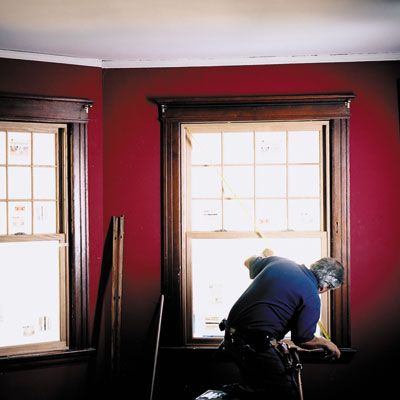
Q: The muntins on my windows have been mangled by sash locks carelessly left closed. Is there a way to repair the damage?
—Laura Mozier, Fairfield, CT
A: As long as you’re planning to paint the window, the best method I’ve found to repair this sort of damage is with a slow-curing architectural epoxy and a plastic spreader shaped to match the muntin’s profile. You can use this same trick to restore the profile on any damaged trimwork around your house.
Repairing Window Muntins: Step 1
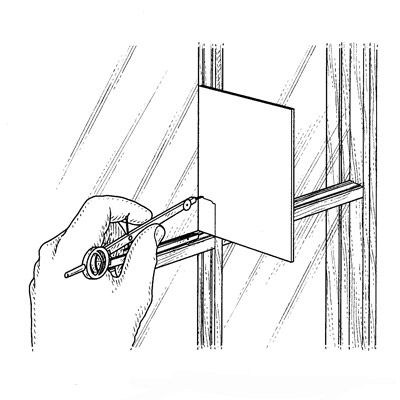
1. Holding the spreader vertically, place it square against the glass and one of the undamaged horizontal muntins. Draw a vertical line about 1 inch long on the spreader even with the muntin’s outer edge. Set the points of a compass about 1 inch apart. Keep them aligned vertically as you run one point over the muntin profile. The other point traces the profile on the spreader. Cut along the layout lines with a coping saw or utility knife. Check that the final profile is smooth and matches the profile on the muntin exactly.
Repairing Window Muntins: Step 2

2. Mask off the glass with painter’s tape beside the area you’re repairing. Wearing gloves, mix a small batch of epoxy until it’s the consistency of peanut butter. Dab a thick coat onto the damaged area with a plastic putty knife.
Now place the spreader vertically on the glass and drag its profiled cutout slowly across the muntin, scraping away the excess epoxy. One pass should be enough for shallow repairs. If the damage is deep, add more epoxy and make more passes. After the epoxy hardens, sand, prime, and paint it.
Replacing Door Hardware
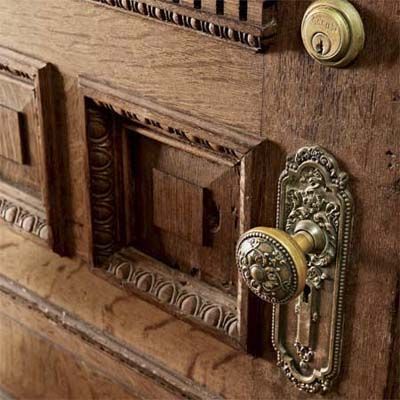
Q: I bought a beautiful old five-panel door, but the old holes for the latches and knobs aren’t in the right places. Can the door be repaired to fit new hardware?
—Eric Fierro, Norwalk, CA
A: Yes, it can. Filling the old holes with custom-cut plugs is fairly easy. The trick is to get the plugs to fit tight and flush so that you won’t see the repair once it’s painted. Here’s how to go about it.
Replacing Door Hardware: Step 1
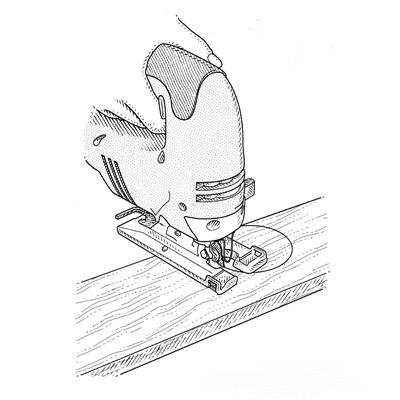
1. Measure each hole, and use a compass to draw two circles on a piece of ¾-inch poplar or pine. Cut out the two plugs with a jigsaw. For a tight fit, make each plug a hair larger than you need and tilt the saw’s shoe so that its blade is angled slightly toward the center of the circle.
Replacing Door Hardware: Steps 2 & 3
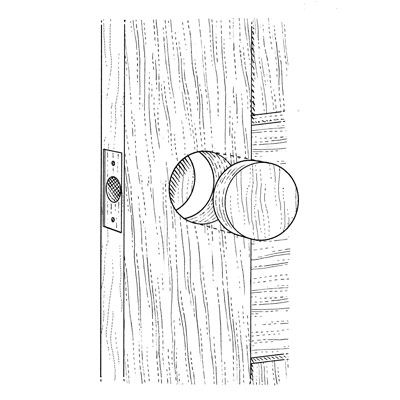
2. Orient the grain of the plugs so that it lines up with the door grain, then glue the plugs in place on each side using yellow woodworker’s glue.
3. When the glue dries, plane or sand the plugs flush, then fill any gaps with wood filler and paint the door. Now it’s ready for you to install the new locksets.
Installing Wall Blocking

Q: I’m building some walls for a basement rec room that will be covered with vertical paneling. How should I install the horizontal blocking that supports it?
—Sean Smith, Cincinnati, OH
A: Fitting lengths of 2x blocking between the studs is useful for paneling. It also helps stiffen tall walls and provides a solid base for attaching cabinets, towel bars, or other wall hardware in a bathroom or kitchen. Use these tricks to simplify the process.
Installing Wall Blocking: Step 1
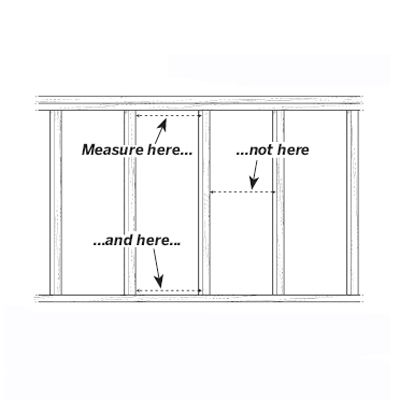
1. Measure and cut each piece of blocking separately because there will be slight variations in the spaces between studs. To get accurate measurements, take them near the top or bottom of the wall; if you take them halfway up the wall, a bowed or loose stud will throw you off.
Installing Wall Blocking: Step 2
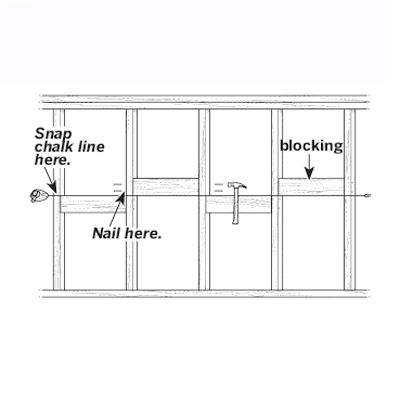
2. This trick will speed up the installation: Snap a level chalk line across the face of the wall where you want the blocking to go; now stagger the blocks above and below the line. This allows you to nail straight through the studs and into both ends of each block, which is much easier than toenailing them if they were in a straight line. If you need a continuous run of blocking—when hanging cabinets, for example—I like to notch a length of 2x material into the wall studs.
Using a Circular Saw

Q: I can’t seem to get a straight cut when I’m using my circular saw with a straightedge. What am I doing wrong?
—Jim Randolph, Long Beach, MI
A: Maybe your straightedge isn’t stiff enough; it might be bowing as you cut. If you really want a straight cut every time, here’s a simple guide you can make out of ½-inch scrap plywood. The guide, sometimes called a shooting board, can be up to 8 feet long, but I find 4 feet to be a useful size, especially for crosscutting plywood.
Using a Circular Saw: Step 1
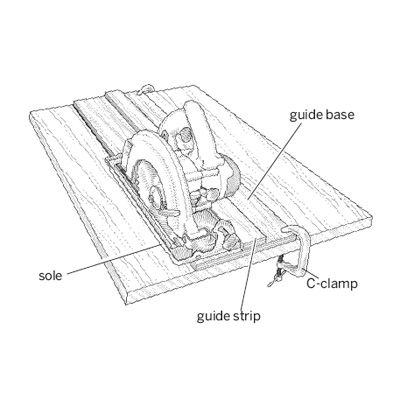
1. To make the guide, take a piece of plywood 7 inches wider than the saw’s sole and cut a 2-inch strip off the factory edge. The remaining piece is the base. Snap a line on the base 5 inches from the edge you cut, then glue and screw the strip facedown, with the factory edge on the line. Now set your saw’s blade ¾ inch deep, put the sole against the guide strip, and trim the base.
Using a Circular Saw: Step 2
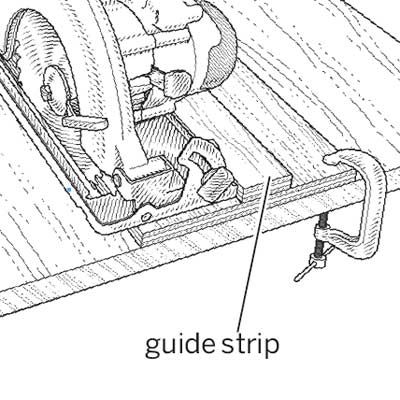
2. To use the guide, align the base’s trimmed edge with the cutline on the workpiece, then clamp the guide at both ends. Set the blade so that it extends about ¼ inch below the work. Place the sole against the guide strip, start the saw, and cut away.
Removing Wood Plugs
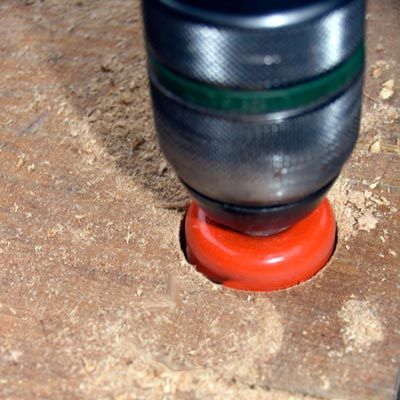
Q: How do you get those pesky wood plugs out of a hole saw?
—Ellen Surles, Annapolis, MD
A: Ejecting a plug from a hole saw is much easier if the plug isn’t too thick. Follow along to find out how to eject plugs of all sizes.
Removing Wood Plugs: Steps 1 & 2
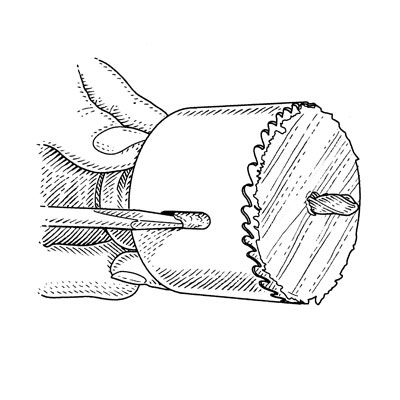
1. If the plug isn’t too thick, just reach in through the saw’s side slots with a screwdriver and pry the plug out, as shown. But if you have to drill through thick material, here are some tricks to use.
2. Drill partway through. If you have access to the other side of the stock, run the hole saw until its guide bit pokes through, then go in from the other side and complete the hole. That way the plug won’t end up completely inside the hole saw and you can easily grab it and twist it out.
Removing Wood Plugs: Steps 3 & 4
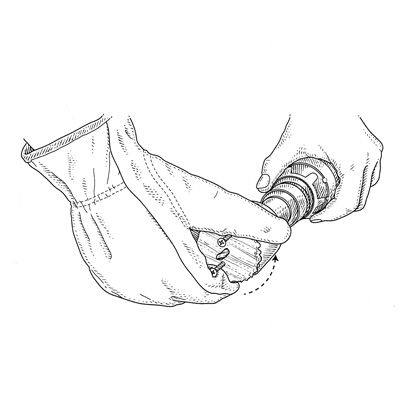
3. Disassemble the saw. Some hole saws can be taken apart, allowing you to push the plug out from the back.
4. Make handles. Drive a pair of screws partway into the face of the plug on opposite sides of the guide bit. Wearing a glove, grab the screws and turn the plug counterclockwise. It will twist right out.
Digging Deck Footings
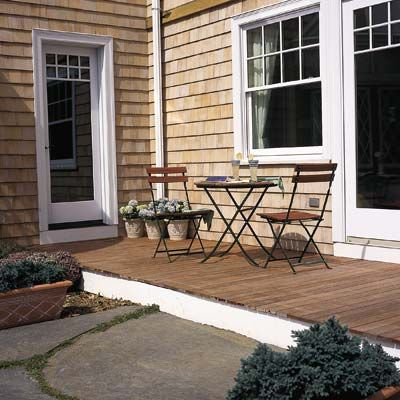
Q: We’d like to build a deck off the slider door in our bedroom. How do we figure out where to dig the deck’s footings?
—Amy Baumgart, Medford, OR
A: The trick I use is the simple 3-4-5 rule from high-school geometry. It says that any triangle with sides that are 3, 4, and 5 feet long forms a 90-degree angle between the 3- and 4-foot sides. The same is true for multiples of those lengths: 6, 8, and 10 feet, or 9, 12, and 15 feet. Longer lengths ensure pinpoint accuracy.
Digging Deck Footings
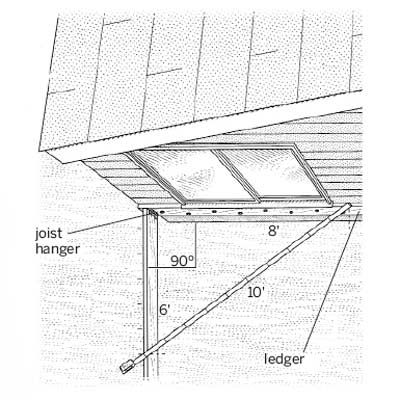
To use your deck as an example, rest one end of a board on a joist hanger attached to the ledger. Mark the top edge of the board 6 feet from the end resting on the hanger. Next mark the ledger 8 feet from the board. Drive a nail into that mark, hook a tape measure on the nail, and extend it to the mark on the joist. Now move the board and the tape from side to side until the 10-foot mark on the tape lines up with the 6-foot mark on the board. The board will then be perfectly square to the ledger. You can drop a plumb bob anywhere along the board to pinpoint the spot to dig your footings.
Drilling a Pilot Hole
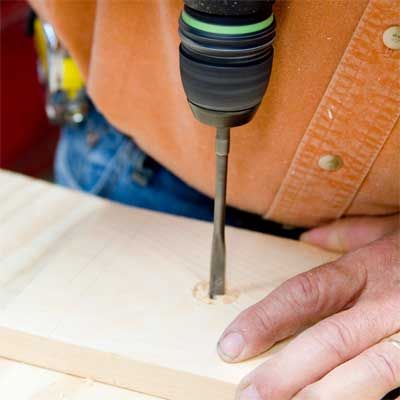
Q: When I drill a pilot hole for a screw, how deep should the hole be, and how will I know if the bit has gone deep enough?
—Steve Bartoletti, Grafton, WI
A: You should always drill a little deeper than the length of the screw. If you don’t, the screw will bottom out before it is fully driven in and the last few turns will be tough, particularly in hardwood. And when you apply more pressure, there’s a greater chance that you’ll mangle the screwhead or scratch your workpiece. These tricks ensure you’ll get the right depth every time.
Drilling a Pilot Hole: Step 1
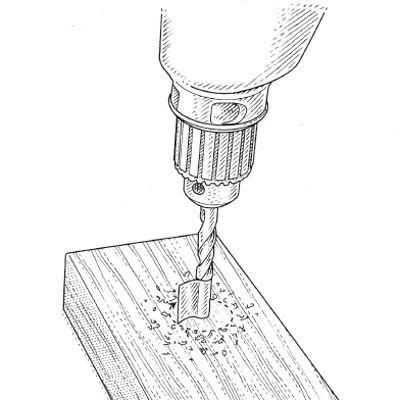
1. With twist bits, I keep tabs on hole depth by wrapping the bit with a piece of blue painter’s tape right at the depth I want. If you’re drilling down, leave a little “flag” of tape sticking out from the bit. It will sweep away the shavings around the bit just as it reaches the desired depth.
Drilling a Pilot Hole: Step 2
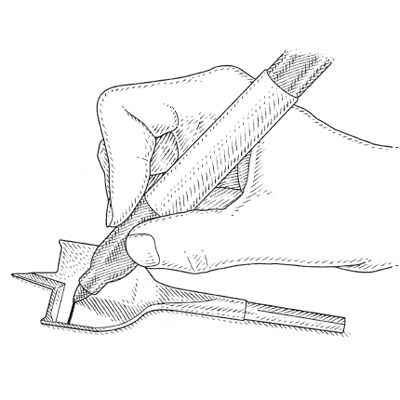
2. When I’m using spade bits to drill counter-bores for nuts, hole depth is critical, so I draw a line on both sides of the bit using a felt-tip pen with permanent ink. The line is easy to see as the bit spins; I just stop when the line is flush with the work surface.
Making a Picture Frame

Q: I’m trying to make picture frames with a miter saw, but the joints aren’t tight. Any way to fix that?
—Jim Morehouse, Crystal, MN
A: Bad miter joints on picture frames are caused by one of two things: Either the saw isn’t cutting the miters accurately or, more commonly, the lengths of the pieces on opposite sides don’t match. With these simple tricks, you can quickly determine the cause of your loose miters. By the way, these techniques also come in handy when installing mitered casing around a window or panel moldings on a wall.
Making a Picture Frame: Step 1
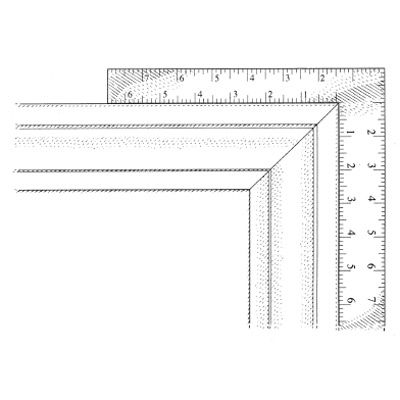
1. To see if the saw’s angle is off, miter two pieces of scrap, then put the miters together and check them with a square, as shown. If the pieces don’t form a perfect 90-degree angle, adjust the angle of the cut slightly until they do.
Making a Picture Frame: Step 2
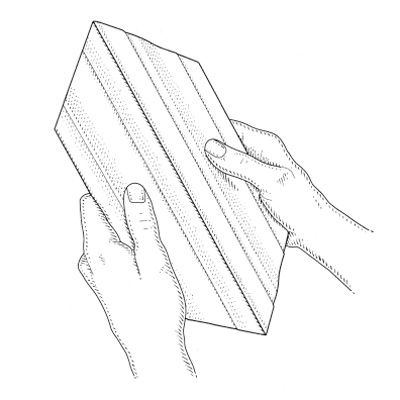
2. It only takes one piece with a slightly incorrect length to throw off the entire frame. So here’s the trick: After you cut the miters for two opposite sides, check their length by putting the long edges together. Both ends should line up exactly, otherwise the joints won’t be tight. This technique is faster and a lot more accurate than trying to measure each piece.
Installing Crown Molding

Q: We’re planning to install expensive cherry crown molding and can’t afford to make any mistakes. Do you have any suggestions for making sure this project goes smoothly?
—Velma Withers, Elwood, NE
A: When installing any wood trim, the key to making accurate cuts is to make clear marks so that you know exactly where to put the miter-saw blade. This is a problem on dark-stained wood or naturally dark woods, like cherry or walnut, because a pencil line is hard to see.
So instead of using a pencil, mark your cuts with a utility knife. It makes supersharp lines that stand out clearly on dark wood. This trick is also useful when laying dark-stained flooring.
Installing Crown Molding

With crown, you don’t need to make a line across the entire piece. A little mark on the edge
is enough to show you where to place your saw blade.
A utility knife’s usefulness as a marking tool is not just confined to dark wood; it’s also the best way to mark the outlines of the mortises for door hinges, lock strikes, and latch faceplates. Because its blade cuts into the wood, you can feel exactly where to rest the edge of your chisel when you start carving out the mortise.
